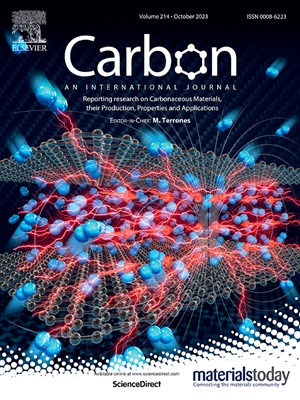CNT 类型、排列和掺杂剂对 CNT 纤维压阻的影响
IF 10.5
2区 材料科学
Q1 CHEMISTRY, PHYSICAL
引用次数: 0
摘要
本文章由计算机程序翻译,如有差异,请以英文原文为准。
The effects of CNT type, alignment and dopants on piezoresistance in CNT fibres
Carbon nanotube fibres (CNTF) are piezoresistive, hence heralded as deformation sensors in applications ranging from flexible touch sensors to artificial skins and robotics. This work studies the piezoresistive behaviour of a wide range of CNT fibres from different sources, processing routes and microstructures. It provides a unifying view of the factors controlling piezoresistance in CNT fibres and related nanocarbon networks. We clarify the role of alignment and concentration of dopants and the constituent CNT type, demonstrating that the origin of piezoresistance in aligned fibres is the direct deformation of the constituent nanotubes, therefore, it is governed by the bulk modulus and thus the degree of CNT alignment. Doping through intercalation, which does not affect modulus or CNT separation, is detrimental to piezoresistive sensing, reducing the gauge factor proportionally to its decrease in resistivity. Aligned fibres show a quasi-linear piezoresistive response, with a positive change in resistance for all deformation modes applied: axial tension, axial or transverse compression. The axial gauge factor is shown to be proportional to fibre Young's modulus, with values of 2–9 for fibres spun from aerogels and above 30 for undoped fibres spun from liquid crystal solutions, respectively. Piezoresistance is attributed to the formation of internal barriers for conduction between metallic regions, which arise from the heterogeneous stress distribution along individual CNTs inherent in shear lag-type stress transfer. Commercial multifilament CNT yarns with a high degree of alignment and a format amenable for integration in large structures have demonstrated the piezoresistive gauge factors of 4 and sufficient sensitivity at strains below 1 % suitable for structural health monitoring of engineering structural composites.
求助全文
通过发布文献求助,成功后即可免费获取论文全文。
去求助
来源期刊

Carbon
工程技术-材料科学:综合
CiteScore
20.80
自引率
7.30%
发文量
0
审稿时长
23 days
期刊介绍:
The journal Carbon is an international multidisciplinary forum for communicating scientific advances in the field of carbon materials. It reports new findings related to the formation, structure, properties, behaviors, and technological applications of carbons. Carbons are a broad class of ordered or disordered solid phases composed primarily of elemental carbon, including but not limited to carbon black, carbon fibers and filaments, carbon nanotubes, diamond and diamond-like carbon, fullerenes, glassy carbon, graphite, graphene, graphene-oxide, porous carbons, pyrolytic carbon, and other sp2 and non-sp2 hybridized carbon systems. Carbon is the companion title to the open access journal Carbon Trends. Relevant application areas for carbon materials include biology and medicine, catalysis, electronic, optoelectronic, spintronic, high-frequency, and photonic devices, energy storage and conversion systems, environmental applications and water treatment, smart materials and systems, and structural and thermal applications.
 求助内容:
求助内容: 应助结果提醒方式:
应助结果提醒方式:


